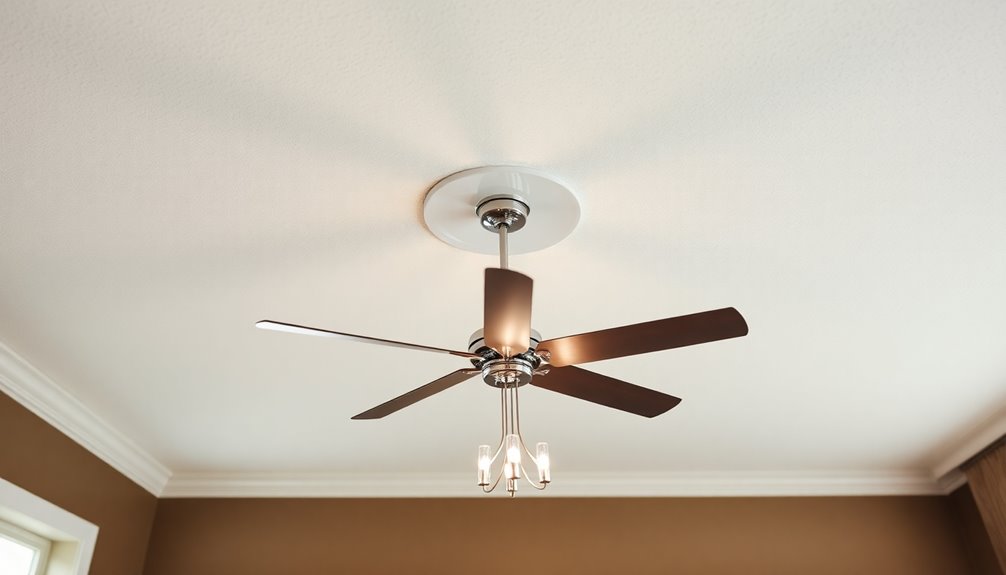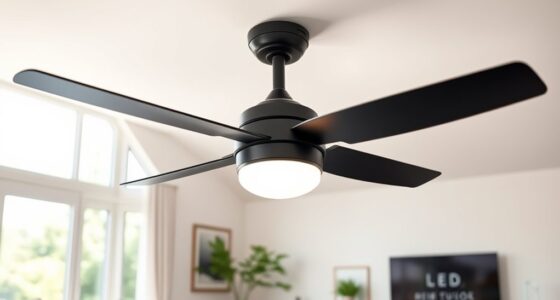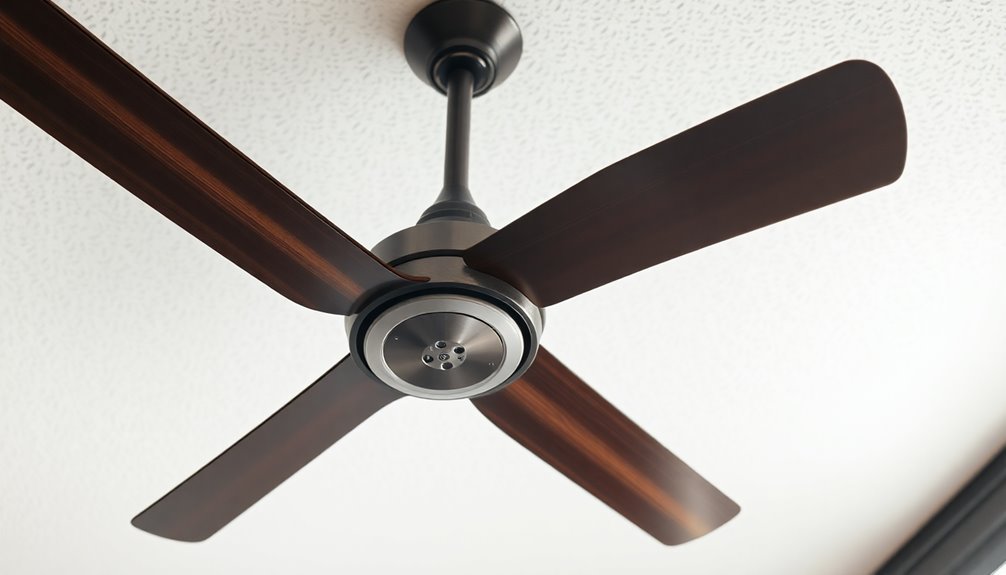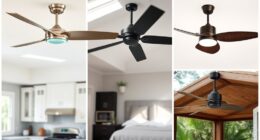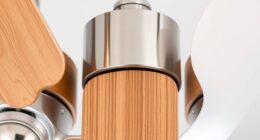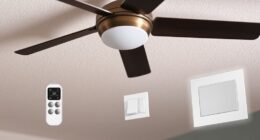Ceiling fans work by using a motor to spin blades, which creates airflow that cools your space. When the blades rotate counterclockwise, they produce a downdraft, lowering the room's temperature during summer. In winter, a clockwise rotation at a low speed creates an updraft that redistributes warm air. The motor, made with copper wire coils, converts electrical energy into the mechanical energy that powers the blades. The design and pitch of the blades are essential for maximizing airflow efficiency. There's much more to explore about these devices, so keep going if you're curious!
Key Takeaways
- Ceiling fans operate by spinning blades, creating airflow that facilitates cooling through the wind-chill effect and evaporative cooling.
- The motor converts electrical energy into mechanical energy, enabling the blades to rotate and manipulate air movement.
- Counterclockwise rotation generates a downdraft for cooling in summer, while clockwise rotation redistributes warm air in winter.
- Blade pitch and design are crucial factors that determine the volume of air displaced and overall airflow efficiency.
- Maintenance, such as cleaning and tightening screws, ensures optimal performance and extends the fan's lifespan.
Principle of Operation

Ceiling fans work by using a motor to spin blades, which creates airflow that cools you through evaporative cooling. The design of the blades plays a vital role in how ceiling fans work. The pitch and shape of the blades affect air movement, with counterclockwise rotation producing a downdraft, effectively lowering the temperature in a room during summer.
In winter, you can switch the direction to clockwise at a low speed, which creates an updraft, circulating warm air trapped near the ceiling back into your living space.
Understanding the principles behind this operation involves fluid dynamics, specifically Bernoulli's law. As the blades spin, they increase air velocity above them, leading to decreased pressure and drawing cooler air from below. This process enhances the cooling effect you feel when standing under the fan.
To maximize efficiency, guarantee proper installation height—7 to 9 feet above the floor and 10 to 12 inches below the ceiling. This prevents obstructions from walls and ceilings, allowing for ideal air movement.
With these principles in mind, you can enjoy the comfort that ceiling fans provide throughout the year.
Key Components

When you look at a ceiling fan, the key components that make it work include the motor and blades, along with the mounting hardware.
The motor powers the blades, creating airflow that cools your space, while the mounting hardware guarantees the fan stays securely in place.
Understanding these elements helps you appreciate how ceiling fans efficiently function in your home.
Motor and Blades
Understanding how the motor and blades work together can greatly enhance your appreciation of ceiling fans. The motor is the heart of the fan, converting electrical energy into mechanical energy through a copper wire coil and rotor. This creates the rotational force that drives the blades.
The blades, typically made from wood, plastic, or metal, are designed in various sizes and shapes, which are vital for the efficiency of airflow. Each blade mounts to the motor at a specific angle, known as blade pitch. This angle is essential for optimizing air movement, allowing the fan to create effective downdrafts for cooling.
To guarantee stability during operation, components like the J hook and U bolt secure the fan to the ceiling, preventing wobbling.
The design and placement of the blades directly affect air circulation; larger blades can move more air at lower speeds. This not only enhances your comfort but also minimizes noise and energy consumption.
Airflow Dynamics
The interaction between the motor and blades sets the stage for how airflow dynamics operate in a ceiling fan. When you turn on the fan, the motor spins the fan blades, creating a downward airflow that greatly enhances air movement in a room.
The design and pitch of these blades play an essential role; a steeper pitch can effectively increase the volume of air displaced, allowing the fan to move air more efficiently.
Inside the fan, the motor consists of a copper wire coil and rotor, which convert electrical energy into mechanical energy for blade rotation. A capacitor helps provide an electrical boost during startup and maintains motor speed, ensuring consistent airflow.
This steady airflow is important for circulating air throughout the space.
Thanks to Bernoulli's principle, the high velocity of air created by the blades results in lower pressure, drawing in air from surrounding areas. This means that as the fan blades move air, they don't just push it down; they also create a continuous cycle that circulates air, promoting a comfortable environment.
Mounting Hardware
Securing your ceiling fan is firmly mounted is important for its performance and safety. The key components of mounting hardware play a significant role in this process. The J Hook attaches the ceiling fan to the ceiling, providing essential support during operation.
Meanwhile, the U Bolt secures the motor to the J Hook, which enhances stability and minimizes vibrations that could lead to wobbling.
For a successful installation, keep these points in mind:
- Mounting hardware must be compatible with your ceiling type (e.g., drywall, concrete).
- Quality hardware enhances stability and reduces wear on the motor and blades.
- Proper installation prevents excessive movement and noise, increasing the fan's longevity.
Using high-quality mounting hardware is important, as it directly affects the fan's overall performance.
When you verify that both the J Hook and U Bolt are correctly installed, you help maintain a stable environment for your ceiling fan, allowing it to operate smoothly and quietly.
Prioritize these components, and you'll enjoy a well-functioning ceiling fan that lasts for years.
Air Circulation Mechanism

When you turn on your ceiling fan, the rotation of the blades generates a powerful airflow that cools you down.
You can control the direction of this airflow, enhancing comfort in both warm and cold months.
Understanding how blade rotation dynamics and airflow direction work together can help you maximize your fan's efficiency.
Blade Rotation Dynamics
Ceiling fan blade rotation plays a fundamental role in air circulation, creating a rejuvenating breeze that enhances comfort in any room. The dynamics of blade rotation are vital for effective cooling. As the blades rotate, they generate a downward airflow, essential for evaporating moisture from your skin, providing that invigorating chill.
Several factors contribute to airflow efficiency:
- Blade pitch: The angle of the blades greatly impacts airflow; a steeper pitch typically results in stronger air movement.
- Blade design: Whether straight or curved, the shape of the blades affects how effectively air is pushed downward.
- Balanced rotation: Properly balanced blades guarantee smooth operation, minimizing wobbling and noise, while maximizing airflow efficiency.
The speed of blade rotation also directly influences air circulation. Higher speeds produce more considerable air movement, improving the cooling effect in your space. Additionally, modern Energy Star certified fans can reduce reliance on air conditioning by raising the thermostat temperature by 4°F.
Airflow Direction Control
Understanding airflow direction control is essential for maximizing the benefits of your ceiling fan throughout the year. Your ceiling fan works by operating in two directions: counterclockwise and clockwise.
In counterclockwise mode, the fan creates a downdraft, pushing air downward to cool a room. This setup increases the evaporation rate of sweat on your skin, giving you a revitalizing breeze without actually lowering the room temperature.
When winter arrives, you can easily switch to clockwise mode using the reverse switch mechanism. In this updraft mode, the fan pulls cooler air up from the floor towards the ceiling, helping to redistribute warm air that tends to be trapped near the ceiling. This effective airflow direction control can greatly enhance comfort in your home.
Moreover, adjusting your ceiling fan's direction can lead to impressive energy savings. By raising your thermostat setting by up to 4°F while using air conditioning, you can reduce energy consumption without sacrificing comfort.
Cooling Mechanism

The cooling mechanism of ceiling fans relies on the principles of evaporative cooling to enhance comfort in warm spaces.
When you turn on a ceiling fan, the air that moves across your skin increases the evaporation rate of sweat. This process creates a cooling sensation, making you feel up to 4°F cooler without actually lowering the room temperature.
The downward airflow generated by the fan blades effectively removes body heat and moisture, providing relief even in sweltering conditions.
Here are some key benefits of using ceiling fans for cooling:
- Enhanced Comfort: The wind-chill effect makes you feel cooler in warm environments.
- Energy Efficiency: Ceiling fans use considerably less energy compared to air conditioning systems.
- Versatile Use: A reverse switch allows for warm air circulation in winter, maintaining comfort year-round.
Energy Efficiency

Fans' energy efficiency makes them a smart choice for cooling your home while keeping costs down. Ceiling fans typically use about 70% less electricity than air conditioning units, making them a cost-effective solution for maintaining a comfortable environment.
By properly using ceiling fans, you can reduce reliance on air conditioning, allowing you to raise your thermostat settings by up to 4°F without sacrificing comfort. This simple adjustment can lead to noticeable savings on your energy bills.
Many modern ceiling fans are Energy Star certified, meaning they're up to 40% more efficient than standard models. This certification guarantees you're choosing an option that maximizes energy efficiency and minimizes costs.
To get the most out of your ceiling fans, use them strategically in occupied spaces, as they work best when people are present.
Additionally, ceiling fans can enhance your HVAC system's efficiency throughout the year. By circulating air in both summer and winter, they help maintain a comfortable climate while potentially reducing overall energy consumption. Energy-efficient heat pumps can work in tandem with ceiling fans to optimize your home's cooling and heating.
In combination with other cooling methods, ceiling fans are an excellent way to create a more energy-efficient home.
Safety and Maintenance

Ceiling fan maintenance is essential for guaranteeing both safety and peak performance. When you take the time to care for your ceiling fan, you not only enhance its functionality but also minimize risks associated with neglect. Always remember to turn off the wall switch before performing any adjustments or maintenance to prevent accidents.
To keep your ceiling fan running smoothly, focus on these key maintenance tasks:
- Regularly clean fan blades and light covers to prevent dust buildup.
- Inspect and tighten screws and bolts every few months to avoid wobbling.
- Evaluate older fans for energy efficiency and consider upgrading to modern models.
If you notice your fan wobbling, it's a sign that maintenance is needed, such as tightening screws or replacing warped blades. By addressing these issues promptly, you can guarantee peak performance and prolong the lifespan of your fan.
Additionally, upgrading to an energy-efficient ceiling fan can improve both safety and performance, making your home more comfortable while reducing energy costs.
Prioritizing maintenance not only safeguards your investment but also enhances your overall living experience.
Installation Considerations

Proper installation is essential for your ceiling fan's performance and safety. First, verify the fan blades are positioned 7-9 feet above the floor and 10-12 inches below the ceiling. This setup maximizes airflow and keeps your space comfortable.
Pay attention to the mounting style you choose: flush mounts work best for low ceilings, while downrods are suitable for higher ceilings, allowing for effective air circulation.
Next, check that the electrical box is secure and rated to support the fan's weight and movement. An inadequate electrical box can lead to safety hazards during operation.
During installation, connect the corresponding colored wires—black for the fan, white for neutral, and green or bare for ground—to verify proper electrical function.
Finally, consider integrating your ceiling fan with lighting features. This enhances functionality and reduces the need for additional light fixtures, making your space feel more inviting. Additionally, selecting a fan with integrated lighting options can provide both cooling and illumination in a single fixture.
Professional Services

When it comes to ceiling fans, enlisting professional services can make all the difference in ensuring your installation is safe and efficient. Hiring experts like RSB Electrical means you'll benefit from their specialized knowledge, guaranteeing that your ceiling fan is set up properly for peak performance and energy efficiency. Professionals understand the importance of using proper placement to ensure effective airflow from your ceiling fan. Additionally, they are well-versed in the significance of energy efficiency to help maximize your ceiling fan's performance and reduce energy consumption.
Their team can assess your unique needs, recommending the best ceiling fan based on factors such as room size and ceiling height.
Here are a few reasons why professional installation is essential:
- Safety Compliance: Expert installation minimizes risks associated with electrical work, ensuring compliance with safety standards.
- Tailored Recommendations: Professionals help identify the most suitable ceiling fan for your space, enhancing functionality.
- Maintenance Services: Regular maintenance keeps your ceiling fan in top condition, extending its lifespan and preventing operational issues.
Additionally, RSB Electrical offers energy efficiency consultations, helping you explore ceiling fan upgrades that can greatly reduce energy consumption and lower your utility bills. They can also provide insights on energy efficiency standards, ensuring your ceiling fan operates optimally while conserving power.
Advanced Fan Technology

As technology advances, ceiling fans have evolved to offer features that enhance comfort and energy efficiency. You'll find that many modern ceiling fans utilize energy-efficient DC motors, which can consume up to 70% less energy than traditional AC motors while still providing comparable airflow. This means you can enjoy a cool breeze without worrying about your energy bill.
Advanced blade technology is another game-changer. Fans are now designed with unique airfoil shapes and optimized pitch angles, maximizing airflow while minimizing noise. This creates a more pleasant environment, whether you're relaxing at home or working in a large space.
For those large areas, high-volume low-speed (HVLS) fans are particularly effective. These fans feature longer blades that move air efficiently at lower speeds, improving air circulation and reducing energy consumption, making them ideal for industrial and commercial settings.
Moreover, smart technology in ceiling fans allows you to control settings remotely and integrate them with home automation systems. Some even have built-in sensors that detect room occupancy, adjusting speed automatically to enhance both comfort and energy savings.
With these advancements, you can enjoy a more efficient and tailored fan experience.
Frequently Asked Questions
How Does a Ceiling Fan Work Step by Step?
To understand how a ceiling fan works, start by ensuring it's properly installed at the right height.
When you turn it on, the motor activates, spinning the blades. As the blades rotate, they push air downwards, creating a cooling breeze.
You can adjust the blade direction based on the season; counterclockwise in summer for a cooling effect and clockwise in winter to circulate warm air.
This simple mechanism enhances your comfort in any season.
How Do Ceiling Fans Work to Cool?
Ceiling fans are like magic carpets for your comfort! They cool you down by creating a revitalizing breeze that makes you feel cooler without actually lowering the room temperature.
When the blades spin counterclockwise, they push cool air down, enhancing the evaporation of sweat from your skin. This wind-chill effect keeps you comfortable during hot days, and when paired with air conditioning, you can save energy while still feeling great!
Do Ceiling Fans Push Hot Air Down?
Yes, ceiling fans do push hot air down when they run in a clockwise direction.
This action creates an updraft, helping to distribute the warmer air that gathers near the ceiling throughout the room.
By doing this, you can minimize cold spots and enjoy a more consistent temperature.
You'll find that adjusting your thermostat a bit higher won't sacrifice comfort, and it can even lead to energy savings during the winter.
Which Way Should a Ceiling Fan Turn in the Summer?
Imagine a gentle breeze dancing through your living room, bringing relief from the summer heat.
To create that invigorating downdraft, your ceiling fan should turn counterclockwise during the summer months. This rotation pushes cool air down, making you feel more comfortable and allowing you to set your thermostat a bit higher.
Conclusion
To sum up, ceiling fans are a smart, energy-efficient choice for cooling your space. You might think they only work in summer, but they're actually great year-round. By reversing the direction of the blades in winter, they help circulate warm air, reducing heating costs. Plus, with proper installation and maintenance, you can enjoy the benefits for years. So, don't overlook ceiling fans—they're a versatile addition that can enhance comfort in any season!



